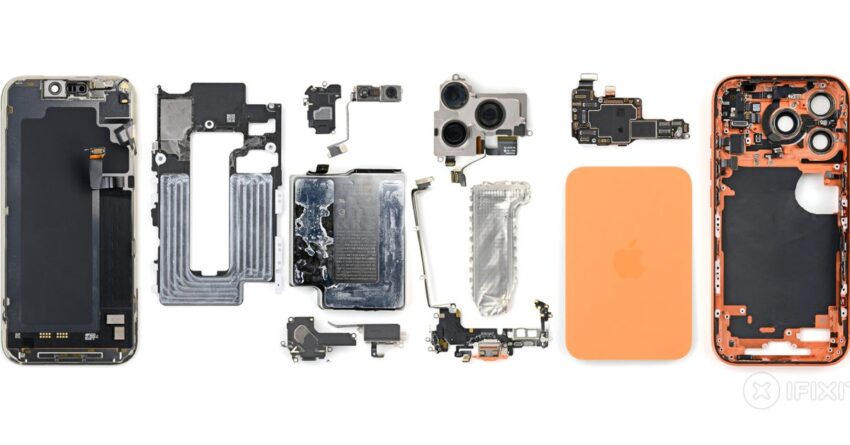
iphone 17 pro teardown reveals vapor chamber iFixit’s recent teardown of the iPhone 17 Pro has unveiled significant internal enhancements, including a new vapor chamber cooling system, while also highlighting some concerns regarding the device’s repairability.
iphone 17 pro teardown reveals vapor chamber
Overview of the Teardown
Following the teardown of the iPhone Air, iFixit has shifted its focus to the iPhone 17 Pro. The analysis reveals a blend of innovative features and some drawbacks, particularly in terms of how easily the device can be repaired. This teardown not only provides insights into the internal architecture of the iPhone 17 Pro but also raises questions about the long-term sustainability and user-friendliness of Apple’s flagship device.
Vapor Chamber Cooling System
One of the standout features discovered during the teardown is the introduction of a vapor chamber cooling system. This technology is designed to enhance thermal management, especially during intensive tasks such as gaming or video editing. The vapor chamber works by distributing heat more evenly across the device, which can help maintain performance levels and prevent overheating.
This advancement is particularly significant given the increasing demands placed on smartphones by high-performance applications. The vapor chamber is a step forward from traditional heat dissipation methods, which often rely on simple heat sinks. By utilizing this technology, Apple aims to ensure that the iPhone 17 Pro can handle demanding tasks without throttling performance due to heat buildup.
Internal Components and Design Changes
In addition to the vapor chamber, the teardown revealed several other internal components that contribute to the device’s overall performance. The iPhone 17 Pro features an upgraded battery, which not only offers longer usage times but also supports faster charging capabilities. The battery’s design has been optimized to fit more efficiently within the device’s sleek profile.
The internal layout has also seen some changes. The arrangement of components has been refined to improve accessibility for repairs, although iFixit still rated the device’s repairability as low. This rating reflects the challenges that users may face when attempting to replace parts such as the battery or display.
Repairability Concerns
Despite the technological advancements, the iPhone 17 Pro has received criticism for its repairability. iFixit noted that while some components are more accessible than in previous models, others remain difficult to replace. For instance, the adhesive used to secure the display is particularly strong, making it challenging for users to open the device without damaging it.
Repairability is a crucial aspect for many consumers, especially those who prefer to fix their devices rather than replace them. The trend towards more complex internal designs can lead to increased costs for repairs, as specialized tools and expertise may be required. This raises concerns about the longevity of the device and the potential for electronic waste, as users may opt to replace their phones instead of repairing them.
Consumer Reactions
The reactions from consumers and industry experts have been mixed. While many appreciate the technological advancements, such as the vapor chamber cooling system, others express frustration over the device’s repairability. Some users have taken to social media to voice their concerns, emphasizing the importance of being able to repair devices easily.
Consumer advocacy groups have also weighed in on the issue, arguing that manufacturers should prioritize repairability in their designs. The right to repair movement has gained momentum in recent years, pushing for legislation that would require companies to make their products easier to repair. The iPhone 17 Pro’s design may be seen as a step backward in this regard, potentially alienating a segment of environmentally conscious consumers.
Implications for Future iPhones
The findings from the iFixit teardown may have implications for future iterations of the iPhone. As Apple continues to innovate and introduce new technologies, the balance between performance and repairability will likely remain a contentious issue. The company has a history of prioritizing sleek designs and advanced features, but this approach may come at the expense of user-friendliness.
Future models may need to address these concerns, especially as consumer awareness of repairability increases. If Apple wishes to maintain its reputation as a leader in technology, it may need to consider the long-term sustainability of its devices and the impact of design choices on repairability.
Market Trends and Competitor Analysis
The smartphone market is evolving, with competitors increasingly focusing on repairability and sustainability. Companies like Fairphone have built their brand around modular designs that allow for easy repairs and upgrades. This trend is gaining traction, particularly among environmentally conscious consumers who are looking for alternatives to traditional smartphone offerings.
As competitors continue to innovate in this space, Apple may find itself under pressure to adapt its designs. The success of the iPhone 17 Pro will likely influence how the company approaches future models, especially in terms of balancing cutting-edge technology with user accessibility.
Conclusion
The iPhone 17 Pro teardown by iFixit has revealed a mix of exciting advancements and notable challenges. The introduction of a vapor chamber cooling system marks a significant step forward in thermal management, catering to users who demand high performance from their devices. However, the concerns surrounding repairability cannot be overlooked. As the right to repair movement gains momentum, Apple may need to reassess its design philosophy to align with consumer expectations for sustainability and accessibility.
Ultimately, the iPhone 17 Pro serves as a reflection of the current state of smartphone technology, where innovation and user-friendliness must coexist. The ongoing dialogue between manufacturers and consumers will shape the future of smartphone design, and it remains to be seen how Apple will navigate these challenges in its upcoming models.
Source: Original report
Was this helpful?
Last Modified: September 24, 2025 at 6:36 am
4 views















